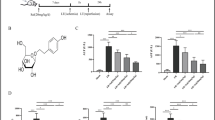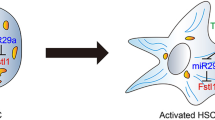Abstract
Background
Recent evidence has indicated that sivelestat, a neutrophil elastase inhibitor, has liver-protective effects in a variety of liver injuries. Proinflammatory cytokines including interleukin (IL)-1β stimulate the induction of inducible nitric oxide synthase (iNOS) gene expression, leading to excess production of NO and resulting in liver damage. We hypothesized that inhibition of iNOS induction underlies the protective effects of sivelestat on the liver. The objective of this study was to investigate whether sivelestat directly influences iNOS induction in cultured hepatocytes, which is used as a simple in vitro injury model, and to determine the mechanism involved.
Methods
Primary cultured rat hepatocytes were treated with IL-1β in the presence or absence of sivelestat. The induction of iNOS and its signaling pathway were analyzed.
Results
Sivelestat inhibited the induction of iNOS mRNA and its protein, followed by decreased production of NO. Transfection and iNOS gene antisense-transcript experiments revealed that sivelestat reduced the levels of iNOS mRNA at both the promoter activation and mRNA stabilization steps. However, sivelestat had no effects on the degradation of IκB and nuclear translocation of NF-κB subunit p65, although it moderately blocked the activation of NF-κB. In contrast, sivelestat blocked the upregulation of IL-1 receptor I through the inactivation of phosphatidylinositol 3-kinase/Akt.
Conclusions
Delayed sivelestat addition experiments demonstrated that the destabilization of the iNOS mRNA contributed more significantly to the inhibitory effects of sivelestat than the reduction in iNOS mRNA synthesis. Sivelestat may provide useful therapeutic effects through the suppression of iNOS induction involved in liver injury.






Similar content being viewed by others
References
Nagino M, Kamiya J, Uesaka K, et al. Complications of hepatectomy for hilar cholangiocarcinoma. World J Surg. 2001;25:1277–1283.
Kawabata K, Suzuki M, Sugitani M, Imaki K, Toda M, Miyamoto T. ONO-5046, a novel inhibitor of human neutrophil elastase. Biochem Biophys Res Commun. 1991;177:814–820.
Zeiher BG, Matsuoka S, Kawabata K, Repine JE. Neutrophil elastase and acute lung injury: Prospects for sivelestat and other neutrophil elastase inhibitors as therapeutics. Crit Care Med. 2002;30:S281–S297.
Tamakuma S, Ogawa M, Aikawa N, et al. Relationship between neutrophil elastase and acute lung injury in humans. Pulm Pharmacol Ther. 2004;17:271–279.
Hayakawa M, Katabami K, Wada T, et al. Sivelestat (selective neutrophil elastase inhibitor) improves the mortality rate of sepsis associated with both ARDS and DIC patients. Shock. 2010;33:14–18.
Zeiher BG, Artigas A, Vincent J-L, et al. Neutrophil elastase inhibition in acute lung injury: Results of the STRIVE study. Crit Care Med. 2004;32:1695–1702.
Yamaguchi Y, Akizuki E, Ichiguchi O, et al. Neutrophil elastase inhibitor reduces neutrophil chemoattractant production after ischemia-reperfusion in rat liver. Gastroenterology. 1997;112:551–560.
Yamaguchi Y, Matsumura F, Liang J, et al. Neutrophil elastase and oxygen radicals enhance monocyte chemoattractant protein-expression after ischemia/reperfusion in rat liver. Transplantation. 1999;27:1459–1468.
Tomizawa N, Ohwada S, Ohya T, Kawashima Y, Takeyoshi I, Morishita Y. The effects of neutrophil elastase inhibitor in hepatectomy with ischemia in dogs. J Surg Res. 1999;81:230–237.
Kushimoto S, Okajima K, Uchiba M, et al. Role of granulocyte elastase in ischemia/reperfusion injury of rat liver. Crit Care Med. 1996;24:1908–1912.
Soejima Y, Yanaga K, Nishizaki T, Yoshizumi T, Uchiyama H, Sugimachi K. Effect of specific neutrophil elastase inhibitor on ischemia/reperfusion injury in rat liver transplantation. J Surg Res. 1999;86:150–154.
Ishii K, Ito Y, Katagiri H, Matsumoto Y, Kakita A, Majima M. Neutrophil elastase inhibitor attenuates lipopolysaccharide-induced hepatic microvascular dysfunction in mice. Shock. 2002;18:163–168.
Kwon A-H, Qiu Z. Neutrophil elastase inhibitor prevents endotoxin-induced liver injury following experimental partial hepatectomy. Br J Surg. 2007;94:609–619.
Shimoda M, Iwasaki Y, Okada T, Sawada T, Kubota T. Protective effects of Sivelestat in a porcine hepatectomy model prepared using an intermittent Pringle method. Eur J Pharmacol. 2008;587:248–252.
Tsuchiya H, Kaibori M, Yanagida H, et al. Pirfenidone prevents endotoxin-induced liver injury after partial hepatectomy in rats. J Hepatol. 2004;40:94–101.
Tsuji K, Kwon A-H, Yoshida H, et al. Free-radical scavenger (edaravone) prevents endotoxin-induced liver injury after partial hepatectomy in rats. J Hepatol. 2005;42:94–101.
Tanaka H, Uchida Y, Kaibori M, et al. Na+/H+ exchanger inhibitor, FR183998, has protective effect in lethal acute liver failure and prevents iNOS induction in rats. J Hepatol. 2008;48:289–299.
Hijikawa T, Kaibori M, Uchida Y, et al. Insulin-like growth factor-I prevents liver injury through the inhibition of TNF-α and iNOS induction in D-galactosamine and lipopolysaccharide-treated rats. Shock. 2008;29:740–747.
Ishizaki M, Kaibori M, Uchida Y, et al. Protective effect of FR183998, a Na+/H+ exchanger inhibitor, and its inhibition of iNOS induction in hepatic ischemia-reperfusion injury in rats. Shock. 2008;30:311–317.
Nakanishi H, Kaibori M, Teshima S, et al. Pirfenidone inhibits the induction of iNOS stimulated by interleukin-1β at a step of NF-kB DNA binding in hepatocytes. J Hepatol. 2004;41:730–736.
Yoshida H, Kwon A-H, Kaibori M, et al. Edaravone prevents iNOS expression by inhibiting its promoter transactivation and mRNA stability in cytokine-stimulated hepatocytes. Nitric Oxide Biol Chem. 2008;18:105–112.
Kanemaki T, Kitade H, Hiramatsu Y, Kamiyama Y, Okumura T. Stimulation of glycogen degradation by prostaglandin E2 in primary cultured rat hepatocytes. Prostaglandins. 1993;45:459–474.
Seglen PO. Preparation of isolated rat liver cells. Methods Cell Biol. 1976;13:29–83.
Horiuti Y, Ogishima M, Yano K, Shibuya Y. Quantification of cell nuclei isolated from hepatocytes by cell lysis with nonionic detergent in citric acid. Cell Struct Funct. 1991;16:203–207.
Green LC, Wagner DA, Glogowski J, Skipper PL, Wishnok JS, Tannenbaum SR. Analysis of nitrate, nitrite and [15 N] nitrate in biological fluids. Anal Biochem. 1982;126:131–138.
Chomczynski P, Sacchi N. Single-step method of RNA isolation by acid guanidinium thiocyanate-phenol-chloroform extraction. Anal Biochem. 1987;162:156–159.
Nishizawa M, Nakajima T, Yasuda K, et al. Close kinship of human 20alpha-hydroxysteroid dehydrogenase gene with three aldo-keto reductase genes. Genes Cells. 2000;5:111–125.
Unezaki S, Nishizawa M, Okuda-Ashitaka E, et al. Characterization of the isoforms of MOVO zinc finger protein, a mouse homologue of Drosophila Ovo, as transcription factors. Gene. 2004;336:47–58.
Schreiber E, Matthias P, Müller MM, Schaffner W. Rapid detection of octamer binding proteins with mini-extracts, prepared from a small number of cells. Nucleic Acids Res. 1989;17:6419.
Oda M, Sakitani K, Kaibori M, Inoue T, Kamiyama Y, Okumura T. Vicinal dithiol-binding agent, phenylarsine oxide, inhibits iNOS gene expression at a step of NF-κB DNA binding in hepatocytes. J Biol Chem. 2000;275:4369–4373.
Bradford MM. A rapid and sensitive method for the quantitation of microgram quantities of protein utilizing the principle of protein-dye binding. Anal Biochem. 1976;72:248–254.
Sakitani K, Nishizawa M, Inoue K, Masu Y, Okumura T, Ito S. Synergistic regulation of inducible nitric oxide synthase gene by CCAAT/enhancer-binding protein β and nuclear factor-κB in hepatocytes. Genes Cells. 1998;3:321–330.
Inoue T, Kwon A-H, Oda M, et al. Hypoxia and heat inhibit inducible nitric oxide synthase gene expression by different mechanisms in rat hepatocytes. Hepatology. 2000;32:1037–1044.
Kitade H, Sakitani K, Inoue K, et al. Interleukin-1β markedly stimulates nitric oxide formation in the absence of other cytokines or lipopolysaccharide in primary cultured rat hepatocytes, but not in Kupffer cells. Hepatology. 1996;23:797–802.
Kleinert H, Pautz A, Linker K, Schwarz PM. Regulation of the expression of inducible nitric oxide synthase. Eur J Pharmacol. 2004;500:255–266.
Matsui K, Kawaguchi Y, Ozaki T, et al. Effect of active hexose correlated compound on the production of nitric oxide in hepatocytes. JPEN J Parenter Enteral Nutr. 2007;31:373–381.
Yamada M, Nishizawa M, Nakatake R, et al. Characterization of alternatively spliced isoforms of the type I interleukin-1 receptor on iNOS induction in rat hepatocytes. Nitric Oxide Biol Chem. 2007;17:98–105.
Matsui K, Nishizawa M, Ozaki T, et al. Natural antisense transcript stabilizes inducible nitric oxide synthase mRNA in rat hepatocytes. Hepatology. 2008;47:686–697.
Teshima S, Nakanishi H, Nishizawa M, et al. Up-regulation of IL-1 receptor through PI3 K/Akt is essential for the induction of iNOS gene expression in hepatocytes. J Hepatol. 2004;40:616–623.
Teshima S, Nakanishi H, Kamata K, et al. Cycloprodigiosin up-regulates inducible nitric oxide synthase gene expression in hepatocytes stimulated by interleukin-1β. Nitric Oxide Biol Chem. 2004;11:9–16.
Pautz A, Linker K, Hubrich R, Korhonen R, Altenhofer S, Kleivert H. The polypyrimidine tract-binding protein (PTB) is involved in the post-transcriptional regulation of human inducible nitric oxide synthase expression. J Biol Chem. 2006;281:32294–32302.
Kawabata K, Hagio T, Matsumoto S, et al. Delayed neutrophil elastase inhibition prevents subsequent progression of acute lung injury induced by endotoxin inhalation in hamsters. Am J Respir Crit Care Med. 2000;161:2013–2018.
Hagiwara S, Iwasaka H, Hidaka S, Hasegawa A, Noguchi T. Neutrophil elastase inhibitor (sivelestat) reduces the levels of inflammatory mediators by inhibiting NF-κB. Inflamm Res. 2009;58:198–203.
Uchida Y, Kaibori M, Hijikawa T, et al. Protective effect of neutrophil elastase inhibitor (FR136706) in lethal acute liver failure induced by D-galactosamine and lipopolysaccharide in rats. J Surg Res. 2008;145:57–65.
Author information
Authors and Affiliations
Corresponding author
Rights and permissions
About this article
Cite this article
Araki, Y., Matsumiya, M., Matsuura, T. et al. Sivelestat Suppresses iNOS Gene Expression in Proinflammatory Cytokine-Stimulated Hepatocytes. Dig Dis Sci 56, 1672–1681 (2011). https://doi.org/10.1007/s10620-010-1520-y
Received:
Accepted:
Published:
Issue Date:
DOI: https://doi.org/10.1007/s10620-010-1520-y




